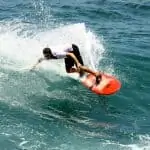Is it Easier to Surf on a Long or Short Board?
Surfing the right board can make all the difference to your progression and fun.
There are so many differences in terms of shape, size and design that thinking about the right board to use can be confusing.
For this reason, a very common question is as follows:
Is it easier to surf on a long or short board? A longboard is much easier to surf because it floats you better and is more stable, meaning you can catch more waves and learn to surf that much quicker. This has many advantages, as we’ll look at in this post in more detail.
Float
A longer surfboard will float you much better than a short surfboard. This means that you will be sitting on top of the surface of the water, which has the following advantages:
- Better visibility of waves coming
- Easier paddling
- Easier to catch waves
Being that bit higher up thanks to better float will mean that you will get more sight of the incoming waves. This means that you can put yourself in the right position faster and then give yourself a better chance of catching those waves.
The extra float also makes paddling easier since you are almost gliding along the surface of the water. On a shorter surfboard, by comparison, paddling will be much harder as the board sinks a bit more into the water, meaning more drag and resistance through the water, and so slower paddling.

Stability
A longer surfboard is also easier because of the extra stability it provides.
Stability is helpful for both paddling and riding waves, as well as taking off.
This comes down to the surface area of the board under your feet, the width and thickness of the board.
As longer boards are wider and thicker than shorter boards, they mean more ‘board’ under your feet and so they are harder to tip and don’t move as much.
This is really helpful when it comes to learning to stand up on your surfboard since it means that the board is more stable under your feet, not rocking back and forth like with a shorter, smaller board.
Again, this extra stability when paddling means that your technique doesn’t need to be as good and that you can paddle much more quickly.
This helps you to catch waves in the early days of learning and also means less effort when out in the water, which is also helpful.
It’s also worth noting that it’s really easy to fall off a surfboard when first learning to paddle as it takes a good few months to really get used to it and get to grips with this strange, new technique.
From there, once you can get up and even ride waves, the same stability helps you to go along the wave without catching the rail of the board.
Basically, surfboards glide through the water by gripping with both the fins and the rails. If you lean too quickly or sharply in one direction, your board will ‘dig’ a rail and throw you off because it’s like an emergency brake in a car!
The wider, more stable template of a longer surfboard means that your rides will be longer in the early days.
Catch More Waves
From the combination of the extra paddle power and stability, you will also be able to catch more waves.
[Q]Remember: catching more waves means learning to surf faster!
It’s also a huge confidence boost when you are a beginner to get lots of waves.
I can tell you from experience, there’s no feeling worse in surfing that paddling out and not catching a single wave in a session, something that happened to me several times when I tried learning to surf with a board that was way too short for me!
On the flipside, going out and getting loads of waves means you can learn more quickly because there is no substitute for that!
It will also leave you much more “stoked” after each session because the thrill of surfing really comes from riding waves.
The more waves per session, the less time it takes to learn to surf!
Shorter Boards for Learners
Can a beginner surfer use a shortboard?
You can find ‘shorter’ surfboards for learners, but remember that shorter always means more difficult in surfing terms. A wide board can suit those who don’t have the space for a longer board, but it must be at least a few inches longer than you are tall.
So, if a shorter surfboard is your only option when learning to surf, look for one that has a soft-top foam construction as these offer more float for their size than standard boards and are thicker than other boards of their length in standard fiberglass/polyurethane constructions.
Here’s my inside tips on the best beginner surfboard brands available for learners, with all being soft-top foam constructions since these are the best option.
Also remember that when you transition to a shorter board, you will need to have much better balance, so you would need to add to your skills out of the water using things like a balance board.
If this sounds like you, definitely check out my full list of tips on learning to surf without water in this detailed guide I’ve prepared just for you!
You can still learn with shorter surfboards but it’s worth remembering that it will take you longer than if you have a longer surfboard.
As such, have that in mind and be patient since learning to surf is a slow process at the best of times.
Related Questions
What is the easiest board to surf on? A soft-top board that is 2 feet longer than you are tall is the easiest. Make sure that it is also wide and round, not short and pointy. This means that it will be much more stable and also easier to learn on.
This post on the best beginner surfboard brands runs through some of the best options from an ‘ease-of-use’ point of view.
Can you teach yourself to surf? Yes, you can definitely teach yourself but it’s always recommended either to have one surf lesson to start or to go with someone who knows what they are doing. This will mean that you can learn much faster.
If you want a clear idea of how long it will take you to learn to surf, check out my guides to this on this super helpful post: How Long Does it Take to Learn to Surf? Beginner to Advanced
How do you know what size surfboard to get? When first starting, look for a board that is 2 feet longer than you. A wide, generous template will also help. From there, you can gradually progress to shorter boards in future, each time taking a few inches off the length.
Also keep a note of the volume on each board you use to learn to surf since this is another really helpful thing to know
The volume can help you to compare boards that might look similar in terms of dimensions but they may be hiding extra ‘foam’ in the way that they have been made, which can be seen in the volume.
As a learner, always go for a board with more volume if you have the choice between two different options since more volume = more float and probably more fun!




